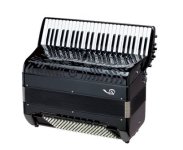So if we consider that it is useful to have C7, for musical reasons, then that is something easily achievable in both button and piano accordions. However, my experience of playing a 45 or 47 key instrument, is that they are quite large and weighty. This issue can be negated by 19mm keys, which brings the overall bulk of a classical piano accordion down close to the size of a 41 key instrument.
However, for the fullest possible treble range of notes, there is only one solution, which is the 64 note button accordion. The full canvas of sound, however still comes at a heavy cost. Such instruments are often 14kg and higher. In my opinion, this not an acceptable price to pay for the full spectrum of sound.
This is where I refer back to Galliano. He plays a button instrument model that according to Victoria's website is around 11.8kg, and he has the same 47 note range that's common to piano accordion too.
Thing is, when you have gone to 64 notes, it's maybe not possible to go back to smaller instruments, even when they are a comfortable weight...


